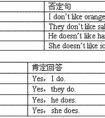— Idon'tlikenoodles.— ______________.[ ]A.SodoIB.SoIdoC.NeitherdoID.NeitherIdo-六年级英语
题文
| — I don't like noodles. — ______________. |
|
[ ] |
| A. So do I B. So I do C. Neither do I D. Neither I do |
答案
| C |
据专家权威分析,试题“— Idon'tlikenoodles.— ______________.[ ]A.SodoIB.SoIdoC..”主要考查你对 副词,倒装句 等考点的理解。关于这些考点的“档案”如下:
副词倒装句
考点名称:副词
- 副词:
用来修饰动词、形容词、其他副词或全句的词,表示时间、地点、程度、方式等。 - 分 类:
1) 时间和频度副词:
now,then,often,always,usually,early,today, lately, next,last,already,generally,frequently, seldom,ever,never,yet,soon,too, immediately, hardly,finally,shortly, before, ago,sometimes, yesterday.
2) 地点副词:
here, there, everywhere, anywhere, in, out, inside, outside, above, below, down, back, forward, home, upstairs, downstairs, across, along, round , around, near, off, past, up, away, on.
3) 方式副词:
carefully, properly, anxiously, suddenly, normally, fast, well, calmly, politely, proudly, softly, warmly
4) 程度副词:
much,little, very,rather,so,too,still, quite, perfectly, enough, extremely, entirely,almost, slightly.
5) 疑问副词:
how, when, where, why.
6) 关系副词:
when, where, why.
7) 连接副词:
how, when, where, why, whether. 副词的位置:
A、副词修饰动词(包括动名词和分词)时,通常位于被修饰动词的后面。
例:Shestudieshard.她学习努力。
B、副词修饰形容词是,通常放在该形容词的前面。
例:LiMingistooyoung.Hecan’tcarrytheheavybox. 李明太小,他搬不动这个重箱子。
C、副词修饰其他副词时,通常放在被修饰副词的前面。
例:Thegirlsingsverywell.这个女孩歌唱得非常好。副词用法:
副词在句中可作状语,表语,补语。
He works hard.
他工作努力。
You speak English quite well.
你英语讲的很好。
Is she in ?
她在家吗?
Let's be out.
让我们出去吧。
Food here is hard to get.
这儿很难弄到食物。
考点名称:倒装句
- 倒装句:
为了强调、突出等语用目的而颠倒原有语序的句式叫做倒装句。
在英语中,我们把主语在前谓语动词在后的句子叫陈述句,把谓语动词放在主语前面的句子叫倒装句。 - 完全倒装和部分倒装:
如果全部谓语放在主语之前,叫完全倒装;
如果只把助动词或情态动词放在主语之前就叫部分倒装。
A、完全倒装
a. 用于there be句型。 例:
There are some students in the classroom. 教室里有几位学生。
There is a tall tree in front of the classroom. 教室的前面有一棵大树。
b. 用于“here(there, now, then)+实义动词+主语”的句型中,或以 in,out,up,down,away 等副词开头的句子里,以表示强调。 例:
Here comes the bus. 汽车来了。
There goes the bell. 铃响了。
Now comes your turn. 现在轮到你了。
Out went the children. 孩子们出去了。
注意:
a.主语是代词时,主语和谓语不能倒装。
b.here,there 放在句首通常用一般现在时。 例:
Here it is. 给你。(你要的东西在这儿。)
Here he comes. 他来了。
c.用于so,neither,nor开头的句子,表示重复前句的部分内容。原句的谓语应与前句的谓语的时态、形式相一致。
He has been to Canada. So have I. 他去过加拿大,我也去过。
You can't speak French. Neither can she. 你不会说法语,她也不会。
表示前面所述的情况也适合于后面一个人或事物,通常在so后用倒装句式(部分倒装用一般问句的形式):
He likes English. So do I. 他喜欢英语,我也一样。
He was ill and so were his parents. 他病了,他父母也病了。
但是如果前面所述情况为否定式,则用neither,nor引出倒装句(此时不能用so):
He couldn’t do it, and neither could she. 他做不了,她也做不了。
He never comes late. Nor do I. 他从不迟到,我也从不迟到。
后一句子若只是重复前句的意思,起加强语气的作用,so后面不用倒装句式:
—He has done a good job. 他干得不错。
—So he has. 他的确干得不错。
B、部分倒装。(小学阶段出现情况较少,在此不作进一步解释) - 倒装句使用情况:
1. 在以here,there,up,in,out,away,off等表示方位的副词开头的句子里, 主语是名词时,句子要用倒装,以示强调;但主语是代词时,主谓不倒装。如:
Away flew the birds.
Out rushed the children.
There goes the bell.
2. 以only修饰的副词、介词短语或状语从句(自身不倒装)位于句首时,常用倒装句。如:
Only when the war was over in 1949 was he able to go to school.
Only in a big city was it possible for him to buy a wheelchair.
Only after I read the text over again did I know its main idea..
3. 在so(肯定句),neither和nor(否定句)引起的句子中, 表示上文所讲的某种情况“也”适合于下文的另一人物时, 用倒装。如:
Lucy likes China. So does Lily.
Tom doesn’t like bananas. Neither/Nor do I.
【注意】如果so不是表示“也”的意思,而是表示“的确”、“果真如此”时,即使它位于句子开头也不用倒装的形式;
另外,如果在讲前面的某种情况时既含有动作动词又含有be动词,(或者前面所讲的情况既有肯定又有否定或者两个主语既有人又有物),再讲后面的另一人物“也”是这样时,要用so的特殊句型, 但还是用正常语序。如:
John won first prize in the contest. So he did.
She is a good girl and she likes English very much. So it is with Han Mei.
Lucy is an American, she doesn’t like Chinese tea. So it is with Lily.
4. 在so…that(如此…以至于)句型中,如果so连同状语一起位于句首时,也用倒装形式。如:
So tired was he after a long journey that he couldn’t stay up.
5. 在as以引导的让步状语从句中,谓语动词以后的部分倒装(提到as之前)。如:
Young(Child)as he is,he knows a lot about computer.
【注意】在as引导的这种倒装的让步状语从句中,被倒装的部分一般分为三种:
表语、状语和动词原形。如果表语是不带定语的单数可数名词,前边的a(an)要省去;
被倒装的动词原形常与may、might、will、would等词连用,而这些词都要保留在原来的位置上。
此外,这个倒装在句首的动词原形不能是连系动词(若是连系动词,倒装的部分是表语),一般多为不及物动词。再看另外的两个例句:
Much as I hate him, I will not kill him.
Try as he might, Tom could not find a job.
6. 表示否定意义的副词或连词位于句首时,要用倒装。常见的这类词语有:
not、never、seldom、rarely、hardly、by no means、in no time、little等。如:
- 最新内容
- 相关内容
- 网友推荐
- 图文推荐
| [家长教育] 孩子为什么会和父母感情疏离? (2019-07-14) |
| [教师分享] 给远方姐姐的一封信 (2018-11-07) |
| [教师分享] 伸缩门 (2018-11-07) |
| [教师分享] 回家乡 (2018-11-07) |
| [教师分享] 是风味也是人间 (2018-11-07) |
| [教师分享] 一句格言的启示 (2018-11-07) |
| [教师分享] 无规矩不成方圆 (2018-11-07) |
| [教师分享] 第十届全国教育名家论坛有感(二) (2018-11-07) |
| [教师分享] 贪玩的小狗 (2018-11-07) |
| [教师分享] 未命名文章 (2018-11-07) |

![_____________ are the gifts for you. [ ]A. These B. They C. Here-六年级英语](http://www.00-edu.com/d/file/ks/4/1/42/2019-08-19/smallb74667ee7b98b5f4a02da9ddd66c0d761566229906.gif)
![Whichofthefollowing means "Noleftturn"?[ ]A.B.C.D.-六年级英语](http://www.00-edu.com/d/file/ks/4/1/42/2019-08-19/small2f91397a71cd5ff565aa5e6cae7f65e71566229608.gif)
![LiMing __________ backwards __________.[ ]A.skate,slowB. skates,slowC. skates,slowly-六年级英语](http://www.00-edu.com/d/file/ks/4/1/42/2019-08-19/smalleb33afabbe986bca37acc8f96e3be4f31566229848.png)
![I can't hear you. Please read it ____________.[ ]A. slowlyB. loudlyC. quietly-六年级英语](http://www.00-edu.com/d/file/ks/4/1/42/2019-08-19/smallefe56863e6931564a691a2e6ac7476ef1566230142.jpg)

